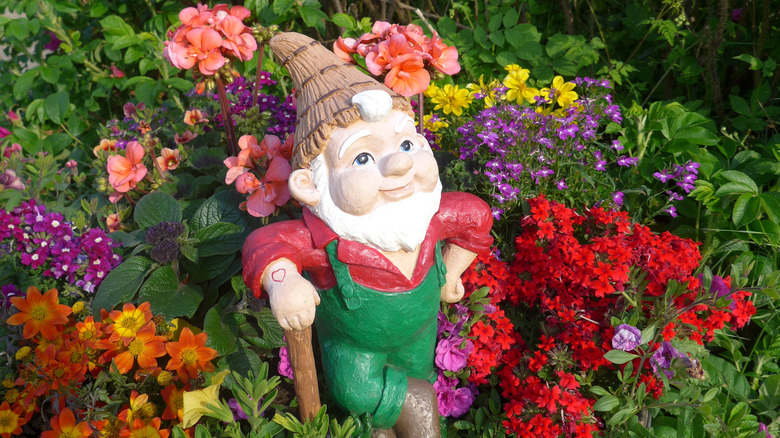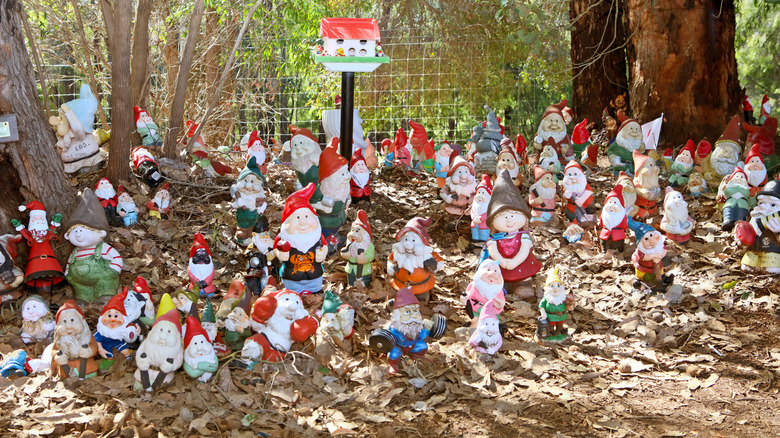Why Do People Put Garden Gnomes In Their Yard?
Ask a dozen people why they've made garden gnomes their yard ornament of choice, and you'll likely get a dozen different answers, as well as an extended story or two. Do these tiny statutes actually contribute to the wellness of a garden? Well, not particularly. You can find much better solutions for keeping pests out of your yard. The true allure of a garden gnome lies in its storied history, where folklore has created a mystified, almost superstitious role for the humble gnome. Plus, the style of this décor has evolved so much over the gnome's existence that you can find one to match whatever outdoor persona you want to portray.
Garden gnomes as we know them today originated in the early years of 19th century Germany. What began as modest clay figurines turned into mass-produced miniature statues made of ceramic and terracotta. Philipp Griebel and August Heissner are credited as the two largest producers at that time, and the factory of the former, Zwergstatt Gräfenroda, still exists today. Their website reiterates the purpose of gnomes long established by fairy tales and folklore; these ornaments are there to protect garden treasures and bring good luck. If you dig deeper into the past and present lives of these gnomes, however, you'll find many stranger tales.
The weird history of garden gnomes includes liberation and actualization
History buffs will tell you the inspiration for gnomes and the good luck they bring to the shrubbery goes back centuries before the Germans cast them in ceramic. Similar characters can be traced back to ancient Rome and later the Renaissance. Perhaps the oddest precursor, however, is found in 18th-century England, where the ultra-rich preferred a more realistic version. These "hermits in the garden" were real people who were paid to live alone in the lavishly manicured gardens of vast country estates. The job lasted about seven years, and the conditions were extremely poor, as you could imagine.
Another strange bit of gnome history comes from the last 30 years or so, and it traces back to an organization known as the Garden Gnome Liberation Front. Its members commit minor trespassing and burglary offenses to step onto strangers' yards, nab a gnome, and "liberate it" from its garden protection duties. The movement began in France but has since gone international; confirmed gnome-nappings have occurred in the United States and Great Britain, to name a few. Whether these statue swipes are performed by playful pranksters or legitimate liberators is, again, dependent on who you ask.
Garden gnome designs go from common to quirky
Strange history and mythical legends aside, the true purpose of a garden gnome is simple: delight the person who placed it. It's a task easily accomplished thanks to the vast variety of these statues and the unique situations they often portray. The original garden gnomes were depicted as outdoorsmen. They were seen hunting, fishing, woodworking, and, yes, gardening.
The gnomes of today, meanwhile, have expanded their interests. Just type "funny garden gnomes" into Wayfair, and you'll find one conversing with sasquatch, another starting a mariachi band, one guy learning to scuba, another cheering on his favorite NFL team, and a rather fit gnome dancing at the disco. A general Google search will turn up far more results, ranging from whimsical to vulgar. Rap music fans can even adorn their gardens with miniature versions of rap legends, including Biggie Smalls, Tupac, and Snoop Dogg.


